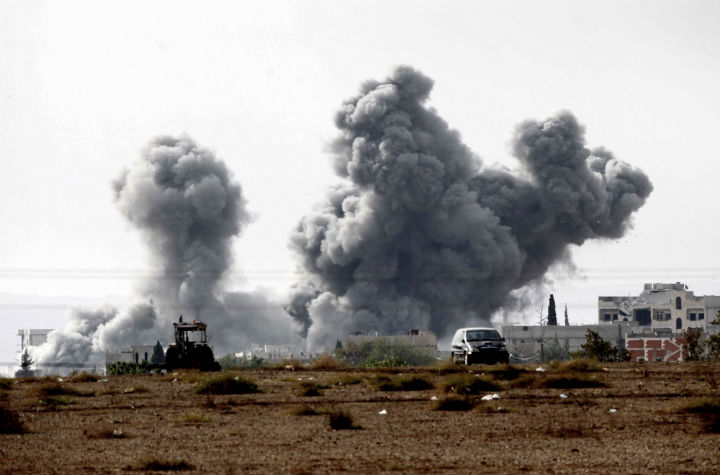WARNING: This story contains graphic content and details. Discretion is advised.

Recently released images that appear to show victims of a chemical attack have raised questions about whether ISIS has acquired and used chemical weapons in Syria.
Photos of the alleged chemical attack victims, their skin burned and melted, appeared online Sunday and according to the Middle East Review of International Affairs (MERIA), which published the photos, it’s possible that ISIS acquired chemical agents from stockpiles in Iraq.
The attack allegedly happened on July 12, in a Kurdish village called Avdiko, on the outskirts of Kobani — the town that has become a focal point in the fight against ISIS and which Kurdish fighters have been battling to save from a complete ISIS takeover for the past month.
Are the claims legitimate?
The alleged attack took place during an earlier Islamic State offensive on Kobani, beginning on July 2.
Jonathan Spyer — a senior fellow at the Global Research in International Affairs Center in Herzliya, Israel, and author of the MERIA report — cited accounts from Kurdish activists and officials detailing how bodies of Kurdish fighters had “burns and white spots” but no signs of bullet wounds.
According to Kurdish authority health minister Ahmed Nissan, whom Spyer cited, that “indicated the use of chemicals, which led to death without any visible wounds or external bleeding.”
The suggestion in Spyer’s report, via “expert Israeli sources,” is that the chemical agent used was “probably mustard (blister agent).”
READ MORE: Islamic State: Why Turkey’s isn’t rushing to take on ISIS
In attempt to verify the photos, Buzzfeed spoke with Jerry Smith — the former head of Syria operations at the Organization for the Prohibition of Chemical Weapons and current head of independent security consultant firm RameHead.
“The limited evidence indicates the people in the photographs have suffered from some from, amongst other possible trauma, chemical burns,” Smith told Buzzfeed.
But, Smith questioned the possibility the wounds were caused by mustard gas.
“Firstly, the boundary between the damaged and undamaged top dermal layers appear to be less apparent than those as with mustard injury,” Smith explained. “Secondly, the exposed lower dermal layers appear far less reddened than those of a mustard injury. Mustard agent causes blistering, and whilst blisters may have burst and been removed, some of the photographs appear to indicate more of a friction, rather than chemical, effect.”
TIMELINE: Rise of ISIS in Syria, Iraq
The MERIA article said Avdiko is a village close to Kobani. The village itself (at least with that spelling) does not show up on Google Maps.
But, Kurdish fighters have struggled to hold off ISIS militants in and around Kobani for some time. U.S. led airstrikes have hit several ISIS targets in the area in the past week, with more than 40 coordinated strikes launched in a 48-hour span this week.
Is there a connection to chemical weapons stashes in Iraq?
While the suggestions in the MERIA report have not been officially verified, there have been concerns ISIS has gained possession of chemical weapons in Iraq and transported them into Syria.
The New York Times on Tuesday published an investigation into the United States keeping secret reports of chemical weapons discoveries in Iraq over the course of seven years, between 2004 and 2011.
“In all, American troops secretly reported finding roughly 5,000 chemical warheads, shells or aviation bombs, according to interviews with dozens of participants, Iraqi and American officials, and heavily redacted intelligence documents obtained under the Freedom of Information Act,” The New York Times reported. The article also detailed several U.S. soldiers being exposed to chemical agents, including mustard gas.
And according to The New York Times, many of the sites where weapons were discovered are in areas now under ISIS control.
READ MORE: Iraqi Yazidi girl held by Islamic State group discusses her ordeal
One such area is the Muthanna Chemical Weapons complex, where Iraq produced chemical agents, including mustard, sarin, and VX, in the 1980s until it was destroyed after Operation Desert Storm.
ISIS took control of the Muthanna complex, about 70 kilometres northwest of Baghdad, in June, during its conquest of Iraqi territory.
WATCH: Amateur video shows alleged aftermath of another chemical weapons attack in Syria
Although much of the plant was incapacitated and later converted into a chemical weapons destruction facility, according to the BBC, bunkers at the site were believed to hold at least 2,500 rockets or remains of rockets containing chemical agents.
While the U.S. was aware of ISIS taking over the Muthanna complex, State Department spokesperson Jen Psaki said only “degraded chemical remnants” remained at the site.
The Guardian reported Psaki saying it “would be very difficult, if not impossible, to safely use this for military purposes or, frankly, to move it.”
READ MORE: Activists, medics accuse Syrian government of chlorine gas attacks (Apr. 23)
But, former British Colonel Hamish de Bretton-Gordon told The Telegraph ISIS “researched the use of chemical weapons in Syria for the last two years.”
“They certainly have access to the al-Qaeda research into chemical weapons and will want to use the legacy weapons in Iraq,” he said.
WARNING: This images below contain graphic content and details. Discretion is advised.
The following photos were posted, along with several others, on the MERIA website.







Comments